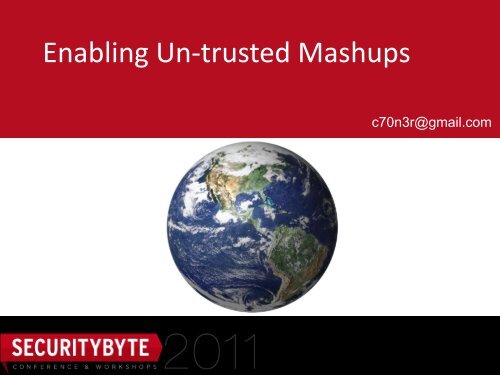Enabling Un-trusted Mashups - Securitybyte
Enabling Un-trusted Mashups - Securitybyte
Enabling Un-trusted Mashups - Securitybyte
You also want an ePaper? Increase the reach of your titles
YUMPU automatically turns print PDFs into web optimized ePapers that Google loves.
<strong>Enabling</strong> <strong>Un</strong>-<strong>trusted</strong> <strong>Mashups</strong><br />
c70n3r@gmail.com
Talk Outline<br />
• Definition<br />
• Web <strong>Mashups</strong><br />
• Mashup Vulnerabilities<br />
• Secure Mashup Principles & Technologies<br />
• Solution: Today and Tomorrow
What is a Mashup?<br />
• An experience delivered by combining<br />
properties of more than one sources
Web Mashup: Types<br />
• An app that combines services from multiple<br />
origins to create new experiences<br />
• Mostly based on DHTML. Also, the focus of<br />
this talk.<br />
• Mashup Approaches:<br />
– Client-side: Browser retrieves and aggregates as<br />
per the provided template<br />
– Server-side: Backend aggregation then serving<br />
pre-composed mashup to the browser<br />
– Hybrid: Leverages benefits of approaches above<br />
Note: From here on we refer web mashups as mashups
Web Mashup: The Business Case<br />
• Ads were and will remain to be the backbone<br />
of Internet business model<br />
– User behavioral targeting, social and interactive<br />
ads are set to revolutionize further<br />
• Social plugins and 3 rd party widgets help<br />
drive engagement and rich user experience<br />
• Need to grow. Getting viral. Enter app<br />
platforms. The ultimate manifestation of user<br />
generated content in mashups – FB, YAP,<br />
iGoogle
Web Mashup: The Technology Case<br />
• Traditional tech stack provides little or no<br />
control over the embedded service<br />
• Intrinsically insecure model<br />
• Ads do go bad. Widgets do get<br />
compromised.<br />
• But we have a legal agreement?<br />
– Yes, that’s just a partial reactive solution.<br />
– What about 3 rd part developer? Does the<br />
agreement going to stop him sitting in<br />
*&^%$(!, %$@#),......
Web Mashup: Client-side with Ads and Social<br />
Plugins
Web Mashup: Client-side with 3 rd Party developers
Web <strong>Mashups</strong>: Hybrid with 3 rd party developers &<br />
providers
Web Mashup: The Tech Stack<br />
• Server-side: No standard solutions. Mostly<br />
custom implementations, proxies and hacks<br />
• Client-side: The more popular mashup.<br />
Leverages browser SOP (Same Origin Policy).<br />
– Two solutions: Scripts and iframes<br />
– Script based<br />
• Offers NO separation but provides FULL interaction<br />
• Interaction not authenticated, nor can confidentiality or<br />
integrity be ensured<br />
– Iframe based<br />
• FULL separation between cross origins<br />
• NO separation within the same origin<br />
• NO provision for interaction between components
Mashup Vulnerabilities: iframe based<br />
• Malicious Redirection<br />
– top.location = http://s0m3phishing.com<br />
• Fake / Malicious UI<br />
– , window.open()<br />
• Drive-by Downloads/Malware<br />
– Content-Disposition: attachment<br />
• Denial of Service (DoS) and Noise<br />
– Infinite alert()and while loops<br />
• History Sniffing/Mining<br />
– getComputedStyle()<br />
• Referrer Leak<br />
– Referrer: http:///r.html?a=secret&b=private<br />
• LAN Scanning<br />
–
Mashup Vulnerabilities: Script based<br />
• Steal Username, Password and other<br />
secret data by calling, intercepting or<br />
spoofing DOM events like onsumbit<br />
• Steal cookies via document.cookie<br />
• Malicious GET and POST via xhr.open<br />
• Abuse features like autocomplete<br />
• All iframe vulnerabilities<br />
• And, many more……
Redirection Attack: FB iframe tab
Redirection Attack: igoogle gadgets
Fake Login
Fake Login Pop-up
Drive-by Downloads
Drive-by Downloads
DoS / Noise
DoS / Noise
DoS / Noise
History Sniffing/Mining
Referrer Leak
Secure Mashup Principles<br />
• Integrator responsible to enforce intended<br />
separation and interaction<br />
• Separation – Deter interference and<br />
malicious behavior of rogue components<br />
• Interaction – Enable secure crossdocument<br />
messaging
Secure Mashup Principles: Client-side<br />
Developments<br />
• Separation: Iframe sandbox<br />
– When set, enables new restrictions on any content hosted by the iframe<br />
– By default, the content is treated as being from a unique origin, forms and scripts are<br />
disabled, links are prevented from targeting other browsing contexts, and plugins are<br />
disabled<br />
• Interaction: postMessage<br />
– Secure & improved replacement of Fragment Identifier Messaging (FIM)<br />
– Provides controlled and safe cross-document messaging between iframes<br />
– Enables authentication, other than confidentiality and integrity that FIM provided too<br />
– Authentication achieved by browser validating the destination when sending a<br />
message and the recipients ability to validate sender on message receive.<br />
• Content Security Policy (CSP)<br />
– Primarily designed to defend against XSS, as a side-effect, enables better mashups<br />
– Provides better granularity over authority of components by restricting their capabilities<br />
that make certain attacks possible<br />
• eval(), setTimeout(), javascript:, new Function(), onclick() and the likes are<br />
restricted
Secure Mashup Principles: iframe Sandbox
Secure Mashup Principles: iframe Sandbox<br />
Pros<br />
• Simplicity and low learning curve<br />
• Incremental features lead to better adoption within devs<br />
• Better adoption by browser vendors being part of HTML5 std<br />
• Completely backward compatible<br />
• Minimal hooks needed on existing code base<br />
• Excellent support on mobile browsers<br />
Cons<br />
• Not production ready!<br />
– No support in older browsers (IE6 must die!)<br />
– Not a replacement but complement to existing defenses<br />
– Supported only in Chrome. FF proposes through CSP but yet to<br />
be implemented. No support in IE
Secure Mashup Principles: postMessage
Secure Mashup Principles: postMessage<br />
Pros<br />
• Nearly production ready<br />
– Supported by all major browsers (FF, Chrome, and<br />
IE8+ covers 85% browser market share)<br />
• Simplicity and low learning curve<br />
• Better adoption by browser vendors being part of<br />
HTML5 std<br />
• Excellent support on mobile browsers<br />
Cons<br />
• No support in older browsers
Secure Mashup Principles: CSP<br />
Pros<br />
• Good granular control over authority of<br />
components<br />
• Simplicity and low learning curve<br />
Cons<br />
• Not production ready!<br />
– No support in older browsers<br />
– A Mozilla standard supported only by FF4+.<br />
Chrome is next. No word on IE<br />
– Moving spec. Needs more scrutiny
Secure Mashup Principles: Server-side<br />
Developments<br />
• Interaction delegated to browser SOP<br />
• Separation introduced by implementing<br />
object capability model i.e. an object cannot<br />
be created if there is no reference to it<br />
– Achieved by restricting JavaScript (JS) to a<br />
subset and providing run-time control over<br />
specific operations, such as DOM access.<br />
• Popular implementations include – Caja,<br />
FBJS, AdSafe and Web Sandbox<br />
• Caja better adopted and supported (YAP,<br />
iGoogle, Orkut) compared to others
Secure Mashup Principles: Caja
Secure Mashup Principles: Caja<br />
Pros<br />
• Production ready<br />
• Excellent granular control over authority of components<br />
• Excellent protection against most of the DHTML mashup attacks<br />
Cons<br />
• High learning curve for developers<br />
– Compiling and debugging challenges<br />
– the line numbers don't correspond to line numbers in your source code.<br />
• Not a standard<br />
• Limited adoption over the years<br />
• Limited support for JS libraries<br />
• Limited protection against JS DoS conditions<br />
• Quirky support on old browsers (Again, IE6 must die!)<br />
• Performance hit at compilation and run-time due to virtualization
Secure Mashup Principles: Caja Virtualization
Secure Mashup Principles: Caja – JS DoS Attack
Solution: Today<br />
3 rd Party Partners<br />
• Keep doing what you are doing to sanitize at the<br />
server-side<br />
• Iframe Ads, Widgets and other content. Avoid scripting<br />
• Keep signing/updating legal and security agreements<br />
3 rd Party Developers<br />
• Your choice!<br />
– Minimal policing, low learning, high portability (iframe)<br />
leads to high growth and viral networks<br />
– Policing (Caja, FBJS), high learning curve, low portability -<br />
low growth
Solution: Tomorrow<br />
3 rd Party Partners<br />
• One day. Some day. Once those are dead and<br />
buried. Yes, you can leave it to them - Sandbox,<br />
postMessage, CSP.<br />
• Some would still need exceptions<br />
– Iframe Ads, Widgets and other content. Avoid<br />
scripting<br />
• Keep signing/updating legal and security<br />
agreements<br />
3 rd Party Developers<br />
• Iframe sandbox + postMessage + CSP +
References<br />
Web Links<br />
• Yahoo! YAP http://developer.yahoo.com/yap/guide/yap-overview.html<br />
• FB Iframe Tabs http://developers.facebook.com/blog/post/462<br />
• WebSand Project https://www.websand.eu/deliverables/index.html<br />
• WHATWG Blog http://blog.whatwg.org/whats-next-in-html-episode-2-sandbox<br />
• iFrame Sandbox http://www.whatwg.org/specs/web-apps/current-work/multipage/the-iframeelement.html#attr-iframe-sandbox<br />
• postMessage https://developer.mozilla.org/en/DOM/window.postMessage<br />
• HTML5 Demos http://html5demos.com/<br />
• Mozilla CSP http://people.mozilla.com/~bsterne/content-security-policy<br />
• Google Caja http://code.google.com/p/google-caja/<br />
• Caja Playground http://caja.appspot.com/<br />
• Caja DoS http://code.google.com/p/google-caja/issues/detail?id=1406&sort=-id<br />
• Microsoft Web Sandbox http://www.websandbox.org/<br />
• Gadget Hijacking http://seclab.stanford.edu/websec/frames/post-message.pdf<br />
• Browser Security Features http://www.browserscope.org/?category=security&v=1<br />
• Browser Market Share http://www.netmarketshare.com/browser-marketshare.aspx?spider=1&qprid=0&qpcustomd=0<br />
Creative Commons Image Attribution<br />
• Slide 1 http://www.flickr.com/photos/donkeyhotey/5679642883/sizes/o/in/photostream/<br />
• Slide 3<br />
– http://www.flickr.com/photos/jesse_sneed/2383953694/<br />
– http://www.flickr.com/photos/31856336@N03/4848321266/<br />
– http://www.flickr.com/photos/umpcportal/4147481868/










